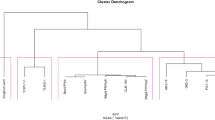Abstract
The fermentation characteristics of 24 strains of Saccharomyces cerevisiae and one strain of Candida apicola, C. famata, C. guilliermondii, Hanseniospora occidentalis, Pichia subpelicullosa and Schizosaccharomyces pombe were evaluated for the production of cachaça. They were isolated from small cachaça distilleries (27), industrial cachaça distilleries (2) and one sugarcane alcohol distillery. The yeasts showed significant differences in ethanol yield, substrate conversion, efficiency, conversion factors of substrate into ethanol (Y p/s), cells (Y x/s), organic acids (Y ac/s) and glycerol (Y g/s), and maximum specific growth rate (μ max). In general the S. cerevisiae strains showed better fermentation potential, with yields between 83 and 91% and μ max between 0.450 and 0.640 h−1, several of them being comparable with the high performance yeast used in the industrial production of ethanol, which was adopted as a reference. The non-Saccharomyces strains showed high efficiency, very low ethanol yield and very high Y ac/s and Y g/s values, except Pichia subpelliculosa, which behaved very similarly to the S. cerevisiae strains. Hierarchical Cluster Analysis and Principal Component Analysis showed the fermentation yield (or substrate conversion) as being the variable which contributed most to the separation of the strains into different groups.
Similar content being viewed by others
References
Andrietta, S.R., Andrietta, M.G.S. & Serra, G.E. 1997 Leveduras não fermentativas – Processo de instalação e forma de deteccçã o e eliminação. STAB, Açúcar, Álcool e Subprodutos 15, 32–35.
Andrietta, S.R., MigliarI, P.C. & Andrietta, M.G.S. 1999 Classificação das cepas de levedura de processos industriais de fermentação alcoólica utilizando capacidade fermentativa. STAB, Açúcar, Álcool e Subprodutos 17, 54–59.
Basso, L.C., Oliveira, A.J., Orelli, V.F.S.M., Campos, A.A., Gallo, C.R. & Amorin, H.V. 1993 Dominância das leveduras contaminantes sobre as linhagens industriais avaliadas pela técnica de cariotipagem. In: 5th Congresso Nacional da STAB: Proceedings of a national workshop held at Águas de São Pedro, São Paulo, Brazil, ed. STAB. pp. 245–250.
Henry, R.J., Cannon, D.C. & Winkelman, J. 1974 Clinical Chemistry Principles and Techniques. pp.1280–1294. New York: Harper and Row Publishers Inc. ISBN 06-141181-7-x.
Kurtzman, C.P. & Fell, J.W. 1998 The Yeasts: A Taxonomic Study. Amsterdan: Elsevier Science Publishers. ISBN 0-44481312-8.
MacGowan, M.W., Artiss, J.D., Strandbergh, D.R. & Zak, B. 1983 A peroxidase-coupled method for the colorimetric determination of serum triglycerides. Clinical Chemistry 29, 538–542.
Morais, P.B., Rosa, C.A., Linardi, V.R., Pataro, C. & Maia, A.B.R.A. 1997 Characterization and succession of yeast populations associated with spontaneous fermentations during the production of brazilian sugar-cane aguardente. World Journal of Microbiology and Biotechnology 13, 241–243.
Oliveira, E.S. 1988 Efeito da adição de suplementos nutricionais na fermentação alcoólica de melaço de cana-de-açúcar em diferentes temperaturas. MS thesis, UFV, Viçosa, Brazil.
Pataro, C., Guerra, J.B., Petrillo-Peixoto, M.L., Mendonça-Hagler, L.C., Linardi, V.R. & Rosa, C.A. 2000 Yeast communities and genetic polymorphism of Saccharomyces cerevisiae strains associated with artisanal fermentation in Brazil. Journal of Applied Microbiology 89, 24–31.
Pataro, C., Santos, A., Correa, S.R., Morais, P.B., Linardi, V.R. & Rosa, C.A. 1998 Physiological characterization of yeasts isolated from artisanal fermentation in an aguardente distillery. Revista de Microbiologia 29, 69–73.
PIROUETTE. 1997 Multivariate Data Analysis for IBM PS Systems, version 2.1. Infometrix, Seattle, WA, USA.
Pirt, S.J. 1985 Principles of Microbe and Cell Cultivation. Oxford: Blackwell. ISBN 063201455-X.
Salik, F.L.M. & Povh, N.P. 1993 Método espectrofotométrico para determinação de teores alcoólicos em misturas hidroalcoólicas. In: 5th Congresso Nacional da STAB: Proceedings of a national workshop held at Águas de São Pedro, São Paulo, Brazil, ed. STAB. pp. 262–266.
SAS Institute 1993 SAS User's Guide: Statistics. Cary, USA. ISBN 1555445543.
Subden, R.E. 1990 Wine yeast: selection and modification. In: Yeast Strain Selection, 1st edn, ed. Panchal, C.J. New York: Marcel Dekker. ISBN 0824782763.
Zimmermann, H.W. 1963 Studies on the dichromate method of alcohol determination. American Journal of Enology and Viticulture 14, 205–213.
Author information
Authors and Affiliations
Rights and permissions
About this article
Cite this article
Oliveira, E.S., Rosa, C.A., Morgano, M.A. et al. Fermentation characteristics as criteria for selection of cachaça yeast. World Journal of Microbiology and Biotechnology 20, 19–24 (2004). https://doi.org/10.1023/B:WIBI.0000013286.30695.4e
Issue Date:
DOI: https://doi.org/10.1023/B:WIBI.0000013286.30695.4e




